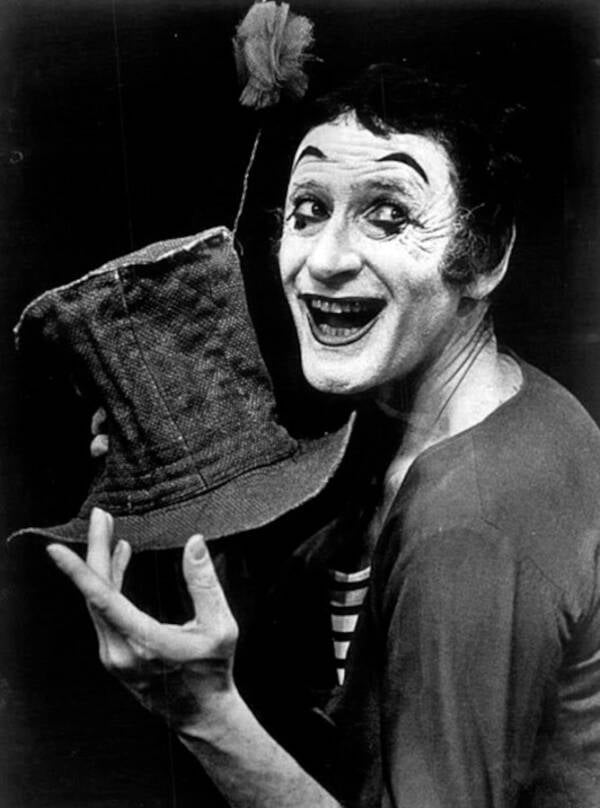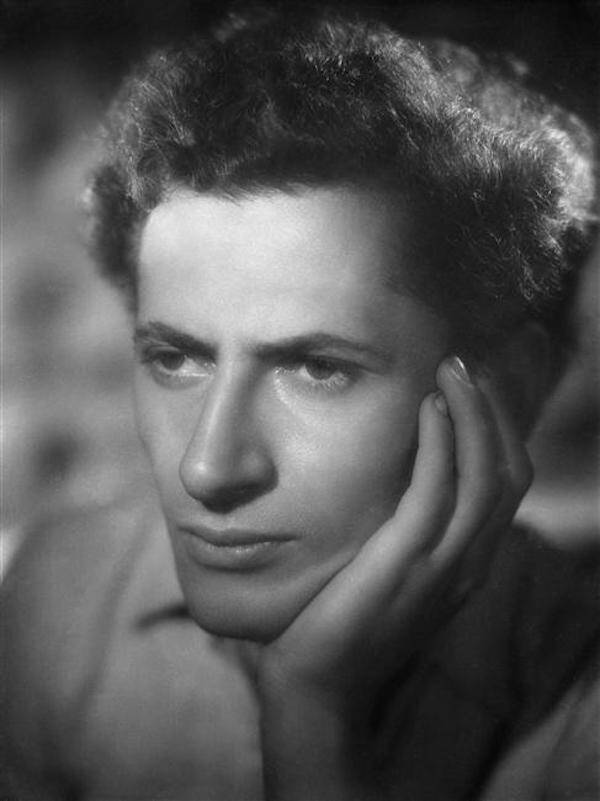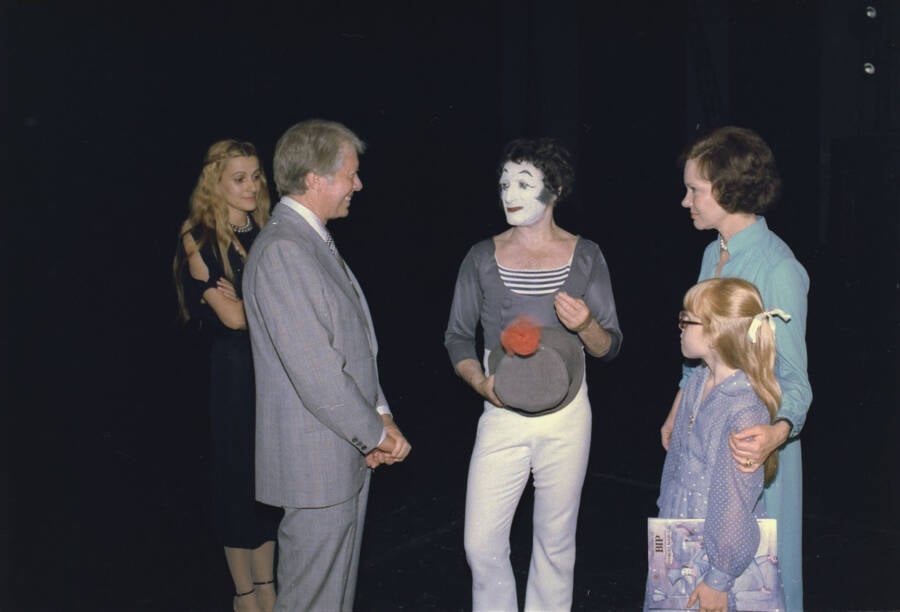As a member of the French Resistance, Marcel Marceau first developed his miming skills to keep children quiet while they evaded Nazi patrols on their way to the Swiss border.
At the mention of the word “mime,” into most people’s minds leaps a picture of a slight figure in white face paint making precise, mesmerizing movements — the very image of Marcel Marceau.
Rising to world renown in the wake of World War II, his techniques, honed over decades in the Parisian theater scene, became the archetype of the silent art form and made him an international cultural treasure.

Wikimedia CommonsBefore Marcel Marceau charmed international audiences as the world’s foremost mime, he played a heroic role in the fight to save Europe’s Jews.
However, what many of his fans may not know is that behind the silent grin of the French mime was a man whose young adulthood had been spent in hiding, aiding the French Resistance, and even heroically smuggling dozens of Jewish children out of the clutches of the Nazis.
In fact, his mime skills were born not in a theater but out of existential necessity to keep children entertained and quiet as they evaded Nazi patrols on the way to the Swiss border and safety. This is the fascinating true story of the French mime who fought with the French Resistance, Marcel Marceau.
Marcel Marceau’s Early Life

Public DomainA young Marcel Marceau pictured in 1946, shortly after the end of World War II.
Born Marcel Mangel in 1923, Marcel Marceau’s parents, Charles and Anne, were among the millions of Eastern European Jews who had traveled west to seek better work and conditions. Settling in Strasbourg, France, they joined a wave of over 200,000 people seeking safety from deprivation and pogroms in the east.
When he wasn’t helping out in his father’s butcher shop, young Marcel was developing an early flair for theater. He discovered Charlie Chaplin at the age of five and soon began imitating the actor’s distinctive style of physical comedy, dreaming of one day acting in silent movies.
He loved playing with other children. He later recalled that it was a place where “my imagination was king. I was Napoleon, Robin Hood, the Three Musketeers and even Jesus on the Cross.”
Marceau was just 17 years old in 1940 when the Nazis invaded France, and Allied forces beat a hasty retreat. Fearing for their safety, the family took flight as well, moving to a series of homes across the country to stay one step ahead of the Nazis.
How Marcel Marceau Joined The Resistance

Library and Archives Canada/Department of National DefenceThe many groups that made up the French Resistance fought for a wide variety of reasons, including political rivalry or efforts to save the lives of those at risk of Nazi violence.
French Jews under the occupation were constantly in danger of deportation, death, or both if local authorities cooperated with German forces. Marcel Marceau was kept safe by his cousin, Georges Loinger, who explained that “Marcel must hide for a while. He will play an important part in the theater after the war.”
The teenager was fortunate enough to continue the education he’d left off in Strasbourg at the Lycée Gay-Lussac in Limoges, whose principal, Joseph Storck, was later declared Righteous Among the Nations for protecting the Jewish students in his care.
He also stayed at the home of Yvonne Hagnauer, a director of a boarding school on the edge of Paris who sheltered dozens of Jewish children during the war.
Perhaps it was the kindness and courage the young man saw in his protectors that encouraged the 18-year-old and his brother, Alain, to join the French Resistance at the urging of their cousin Georges. To disguise their Jewish origins from the Nazis, they chose the name of a French revolutionary general: Marceau.
Marcel Marceau’s Heroic Rescue Missions

Wikimedia Commons“Marceau started miming to keep children quiet as they were escaping. It had nothing to do with show business. He was miming for his life.”
After months forging identity cards for members of the Resistance, Marcel Marceau joined the Organisation Juive de Combat-OJC, also known as the Armée Juive, or Jewish Army, whose primary task was to remove Jewish civilians from danger. The affable Marceau was entrusted with leading groups of children to safe houses for evacuation.
“The kids loved Marcel and felt safe with him,” his cousin said. “The kids had to appear like they were simply going on vacation to a home near the Swiss border, and Marcel really put them at ease.”
“I went disguised as a Boy Scout leader and took 24 Jewish kids, also in scout uniforms, through the forests to the border, where someone else would take them into Switzerland,” Marceau recalled.
His growing skill as a mime came in handy on many occasions, both to entertain his young charges and to communicate silently with them and keep them calm while evading German patrols. Over the course of three such trips, the French mime helped to save more than 70 children from the Nazis.
He even claimed to have used his talent to evade capture himself when he encountered a patrol of 30 German soldiers. With body language alone, he convinced the patrol that he was a forward scout for a larger French unit, convincing the Germans to withdraw rather than face slaughter.
The Last Days Of World War II

Imperial War MuseumThe liberation of Paris in 1944.
In August 1944, after four long years of occupation, the Germans were finally driven from Paris, and Marcel Marceau was among the many who rushed back to the liberated capital. The return of General Charles de Gaulle saw the need to organize the Resistance into the Free French Forces of the Interior to supplement regular French troops.
The Armée Juive became the Organisation Juive de Combat, and Marcel Marceau was now a liaison officer between the FFI and U.S. General George Patton’s 3rd Army.
As the Allies rolled back Axis occupiers across the French countryside, American troops began hearing of a funny young French mime who could mimic nearly any emotion, situation, or reaction, all while completely silent. It was thus that Marceau came to have his first professional performance before an audience of 3,000 US soldiers.
“I played for the G.I.s, and two days later I had my first review in the Stars and Stripes, which was the paper of the American troops,” Marceau later recalled.
The art of mime had nearly died out by this time, but between performances for troops and his own lessons with a master of the art, Marceau began to lay the groundwork he would need to return it to worldwide renown.
The Postwar Legacy Of France’s Greatest Mime

The Jimmy Carter Library and Museum/National Archives and Records AdministrationAfter fighting with the French Resistance, Marcel Marceau would achieve lasting fame as the world’s leading practitioner of pantomime.
With his stage career off to a promising start, Marcel Marceau also took time to visit his childhood home in Strasbourg for the first time since his family had been forced to flee in 1940.
He discovered it bare and learned that, while he’d been fighting to rid his country of the Germans, they’d arrested his father on February 19, 1944, and deported him to Auschwitz, where he died.
The French mime decided to channel the pain of the war years into his art.
“After the war I didn’t want to speak about my personal life. Not even that my father was deported to Auschwitz and never came back,” he said. “I cried for my father, but I also cried for the millions of people who died. And now we had to reconstruct a new world.”
The result was Bip, the comic hero with a chalk-white face and a rose in his hat, who became his most famous creation.
In a career that took him to stages throughout the Americas, Europe, the Middle East, and the Pacific, Marcel Marceau spent over 50 years delighting audiences who often had no idea that the artist before them had also played a heroic role in the fight against fascism.
Speaking at the University of Michigan just a few years before his death in 2007, Marcel Marceau told his listeners that “you need to know that you have to go toward the light even if you know that one day we shall be dust. What is important are our deeds during our lifetime.”
After learning about one of the most famous members of the French Resistance, Marcel Marceau, read about Irena Sendler, “the female Oskar Schindler” who heroically rescued thousands of Jewish children from the Nazis. Then, take a look at how these nine ordinary men and women risked their jobs, safety, and their very lives to protect countless European Jews from death.





